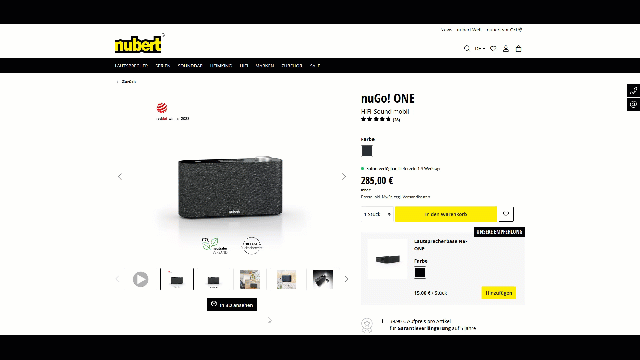Blog
Rethinking the stages of the customer journey with 3D & AR

- Hot Topics
- How to Metaverse
- Blog
The customer journey - the journey that customers go through from the first contact to the final purchase decision and beyond - is a decisive factor for the success of an e-commerce business. But why is it so important to reach customers at every single stage? Quite simply, enthusiastic customers are not only more likely to buy a product, but they are also more likely to return and tell others about the brand. Each of these phases offers unique opportunities to strengthen brand loyalty, maximize satisfaction and ensure business success. In this article, you will learn how to use innovative augmented reality (AR) and 3D technologies to optimize the individual phases of the customer journey in order to inspire customers and strengthen your brand in the long term.

Awareness describes the phase in which people engage with a brand or product for the first time. In the consideration phase, it increases the likelihood that potential customers will opt for your own product rather than that of a competitor. A smooth and pleasant buying process in the purchase phase minimizes the abandonment rate and ensures a higher conversion rate. Long-term satisfaction in the retention phase ensures repeat purchases and builds a stable relationship with the customer. Finally, enthusiastic customers can become strong brand ambassadors in the advocacy phase, gaining new customers through positive word of mouth and recommendations.
From awareness to advocacy: How 3D is reshaping your online marketing
Depending on the product or service and industry, the customer journey can consist of all five or only some of the mentioned phases.
1. Awareness: The first impression counts
The awareness phase is about making potential customers aware of your product or brand. This is where it is crucial to make a lasting first impression. 3D advertising can arouse the interest and curiosity of a younger target group and make it possible to present products or services in an exciting and immersive way. Immersive technologies help to make the brand memorable and stand out from the competition. This is building the foundation for a successful customer journey.
Interactive 3D ads on social media, websites or large billboards, such as those seen on Times Square, allow users to explore products in an entertaining way. One example of this is an interactive jump & run game by the brand Malibu that emphasizes fun and interactivity. An interactive Snapchat game that sweetens the waiting time for users at bus and train stops and presents the brand in an entertaining context.
3D animations are ideal for explaining complex products or services and attracting the attention of the target group. NESTRO Lufttechnik GmbH, a German manufacturer of extraction and filter systems, have integrated interactive 3D models on their website to better explain the machines and how they work.
Also companies like YT Industries are using interactive 3D gaming elements to familiarize customers with products and build a connection that increases the purchase probability. In this example, potential customers can try out bikes on virtual trails and get to know the brand in an entertaining way.
To make this type of customer acquisition even more accessible, it is recommended to use web-based solutions. In this way, customers can access the 3D experience without having to download specific apps and directly on their mobile device. Who would like to download an app just for an advertisement?
2. Consideration: Building trust and enthusiasm
In the consideration phase, customers examine and compare different options to determine which product best serves their needs. Here it is important to gain trust and convince customers of the quality and benefits of the product. 3D product configurators, virtual showrooms and AR views offer the opportunity to discover products online at one's own pace. This interactivity and level of detail increase enthusiasm and trust in the product, which ultimately has a positive influence on the purchasing decision. [1] [2]

Augmented reality allows virtual products to be placed in a real environment. For example, customers can use the website and catalogs of a German furniture retailer named Möbel Boss to test whether the furniture will fit in their home before they buy it. This not only increases their satisfaction through interactivity and the resulting emotional connection, but also reduces the returns rate.
3D product configurators enable potential customers to customize products according to their wishes and visualize them in real time. With this bike configurator from YT-Industries, for example, you can put together your dream bike. The frame size, tire size and color can be adjusted with just a few clicks. This type of mass customization gives buyers a feeling of individuality, even though these products are mass-produced and sold. They can then use the AR feature to project the bike into their own environment and see whether the size fits or if the design they have chosen fits into their collection.

Virtual showrooms offer a walk-in and interactive 3D environment that allows customers to explore products virtually, similar to a physical store. This creates an immersive shopping experience and the feeling of actually being in a store. Customers are able to explore the goods independently.

3D avatars with AI assistance can help to find the right product from a large selection. Automated advice improves the shopping experience, reduces the workload of human service advisors and thus saves costs. This AI avatar in the look of Robert Bosch advises customers and tells the story of the company's founding.
In addition, 3D product visualization enables high-quality renderings of products. It offers detailed views that can be cost-effectively updated at any time as soon as new colors of a product launch, without incurring setup costs for a product photo shoot. All product images and furnishing examples used by IKEA (both in the catalog and online) are created using CGI (computer-generated images).

3. Purchase: A smooth purchasing process for maximum conversion rate
In the purchasing phase, the focus is on the actual buying process and payment transaction. A smooth and user-friendly purchasing process is the key to avoiding abandonment. When shopping online, you want to use just one system and not be disturbed by additional windows or logins. An intuitive and consistent user experience can speed up the process, increase satisfaction and reduce the abandonment rate.
Numerous store system providers offer 3D product plugins that can be used to integrate 3D models of items on product pages with just a few clicks. This allows adding a 360° model with AR function to the product image gallery. Shop software providers such as OXID, Shopware, WooCommerce and many others have already developed corresponding plugins together with rooom.

3D models by rooom implemented in nubert's online store from Shopware.
4. Retention: Ensuring Long-term Customer Loyalty
The retention phase aims to retain customers in the long term after the actual purchasing transaction and ensure their satisfaction. The emotional component is particularly important for this, as it leads to higher customer satisfaction, lower support costs and a stronger bond with the brand in the long term.
Interactive 3D models and tutorials can help with troubleshooting or installing products, for example. Customers can follow user manuals in real time, visually reproduce problems or install products at their own pace. For example, the Wi-Fi router installation instructions of the future could look like this: Thanks to a 3D animation, Wi-Fi routers can be connected independently without having to receive technicians or having to wade through a disdainful paper instruction manual. This will provide optimized support for installation and make it as simple as possible- resulting in happier customers.
Virtual workshops or tutorials enable customers to learn more about the use and care of their products. The medical technology company BD, for example, uses the virtual rooom platform to provide product presentations, documentation, training and education and delivers customer-oriented content.

Customer events and promotions offer the opportunity to talk to others about the products and build a community at the same time. Even companies or service providers without physical products can give their customers the feeling that they are an important part of the company after the purchase. A continuous exchange between customers and companies is an essential step in turning them into brand ambassadors.
5. Advocacy: Winning brand ambassadors
The advocacy phase is all about turning existing customers into advocates for the brand. This means that if they are satisfied with their purchase, they share positive experiences and influence others in their purchasing decision. 3D feedback platforms offer the opportunity to share experiences and adjustments in an interactive format. They promote exchange within the community and inspire others.
By sharing 3D renderings or videos of their use, customers can express their satisfaction, submit feedback and influence other potential buyers. This can not only strengthens loyalty, but also increase the reach and reputation of the brand.
In interactive online communities or platforms, customers can share their own 3D designs or customizations to inspire others and promote the brand. In rooom's open Discord chat, on OMR reviews or on the “Explore” page of the rooom platform, experiences with products can be shared, 3D renderings uploaded and exchanged.

Unleash the power of 3D technologies to revolutionize the customer journey of your online store and offer an unforgettable shopping experience. Book a free meeting with our e-commerce experts now!
The future of e-commerce with 3D technologies
The integration of 3D technologies, such as 3D product views with animation and AR function, is not just a passing trend, but a lasting transformation that is fundamentally changing the way customers experience and buy products. The customer journey should be considered in its entirety. Although it is possible to tackle each step individually, it is best to take a complete view of your own product. From initial attention and detailed product viewing and customization to a smooth purchasing process and long-term customer loyalty - 3D solutions offer many options for optimizing the customer journey.
In the future, these technologies will be further developed and become increasingly important. Advances in virtual and augmented reality, improved 3D rendering techniques, and the integration of artificial intelligence will make the shopping experience even more immersive and personalized. The expansion of 5G network will ensure easy access to content in the future. Companies that adapt to these developments early on will secure a competitive advantage and inspire their customers in a new, fascinating way.
[1] Morales, J., Silva-Aravena, F., Valdés, Y., Baltierra, S. (2022). Virtual Reality and Augmented Reality Applied to E-Commerce: A Literature Review. In: Agredo-Delgado, V., Ruiz, P.H., Correa-Madrigal, O. (eds) Human-Computer Interaction. HCI-COLLAB 2022. Communications in Computer and Information Science, vol 1707. Springer, Cham.
[2] Riar, M., Xi, N., Korbel, J.J., Zarnekow, R. and Hamari, J. (2023), "Using augmented reality for shopping: a framework for AR induced consumer behavior, literature review and future agenda", Internet Research, Vol. 33 No. 1, pp. 242-279.
Author
Contact Sales now
Telephone: +49 (3641) 55494454
Mobil: +49 (178) 8061312
your message here














